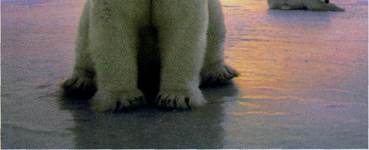b Match six of the words in Exercise 2a with these definitions.
In groups, look at the headline and answer the questions.
1 Why do you think polar bears are in
danger of becoming extinct?
2 What other animals are in danger of
dying out?
Polar bears are facing extinction in the wake of retreating sea ice
A Look at the headline again and predict which ten of the following words will appear in the article.
banks cubs deserts fast (n) fat (n) icebergs mammals marine penguins prey seals species thrive waves
b Match six of the words in Exercise 2a with these definitions.
1 eating no food at all for a period of
time
2 a group of animals or plants of the
same kind
3 an animal that is hunted and eaten by
another animal
4 young bears, lions, tigers, etc.
5 animals that feed their young with milk
from their body
6 relating to the sea and creatures that
live there
3 Scan the introduction and the article
and check your answers to Exercise 2a.
4 Read the introduction to the article
and answer the following questions.
1 How long have sea levels been rising?
Are they still rising?
2 How long has polar ice been shrinking?
Is it still shrinking?
3 What success have environmentalists
had in their fight against global
warming?


| W |
e all know that sea levels have been rising For the last 20 years, but the rate of rise has increased rapidly in recent years. Polar ice has been shrinking at a rate of nearly 75,000 square kilometres a year over the last 30 years. Unfortunately, environmentalists have not achieved any significant results in their fight against global warming. So what effect has all this had on Arctic wildlife?
1 The retreat of sea ice in the Arctic is forcing the world's wild
polar bear population into an unnatural fast, which threatens the
species with extinction.
2 Scientists said yesterday that the earlier annual break-up of
sea ice caused by climate change is cutting short the spring
hunting season for the bears, which rely on floating banks of ice
to reach their prey.
3 The disappearance of the sea ice in summer months is forcing
hungry polar bear populations to spend longer on land, giving a
false impression that numbers are increasing as they encroach
on human settlements in search of food.
4 Travel agencies in Canada and the US offering Arctic tours
have begun boasting of the increased likelihood of spotting the
bears.
5 But a joint study by the Canadian Wildlife Service (CWS)
and Nasa published in the scientific journal Arctic this week
has found that, far from thriving, the polar bear is at potentially
irreversible risk from global warming.
6 The research into bears in five Arctic regions found that sea
ice has begun retreating progressively earlier each year when
satellite images from 1979 to 2004 are compared.
7 Female bears rely on the spring hunting season to build the
fat reserves needed to see them through the summer months.
The retreating ice means they have not had time to build up
normal levels of fat - which can reach a thickness of 12cm.
8 The study found the spring hunting season was being
reduced by nearly three weeks in some places - reducing the fat
levels by up to 80kg in each animal.